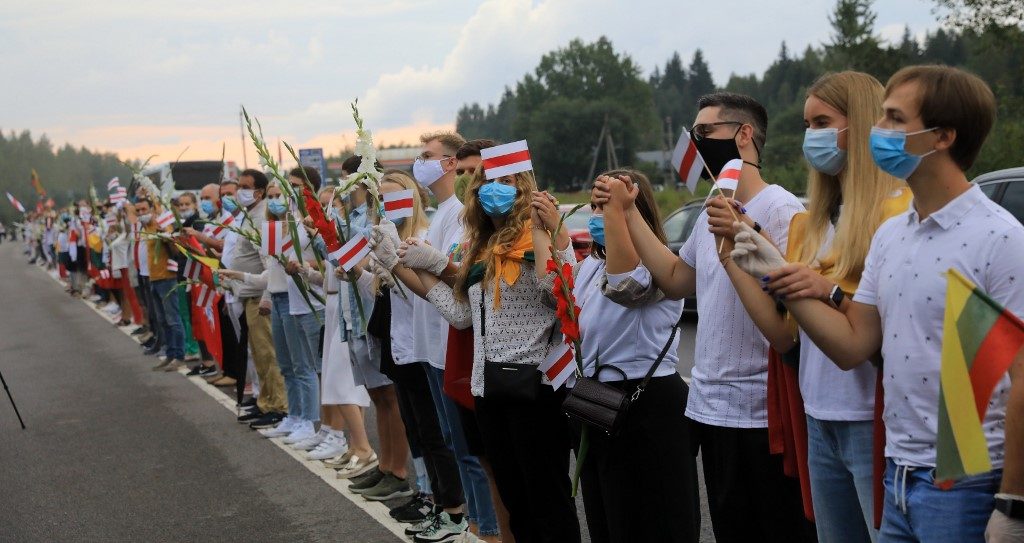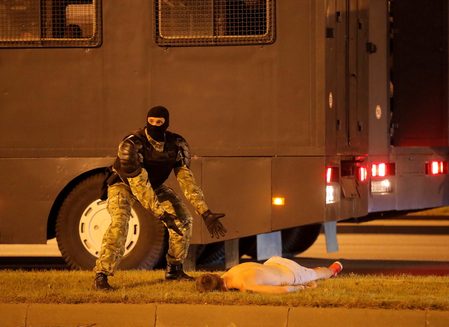SUMMARY
This is AI generated summarization, which may have errors. For context, always refer to the full article.

Tens of thousands of Lithuanians linked arms on Sunday, August 23, in solidarity with the people of neighboring Belarus who have been holding mass protests against authoritarian leader Alexander Lukashenko since a disputed presidential election two weeks ago.
The participants formed a human chain stretching 30 kilometers from the Baltic EU state’s capital Vilnius to the border with Belarus, with many holding the Belarusian opposition’s red-and-white flag as well as the Lithuanian national tricolor.
Solidarity rallies were also held in other European countries, inspired by the historic Baltic Way demonstration on August 23, 1989 when more than one million Lithuanians, Latvians, and Estonians linked hands to reject Soviet rule.
“We are with you, free Belarus, and we extend our hand to you,” Lithuania’s President Gitanas Nauseda said after linking hands at the border checkpoint.
“The nations that had lost their freedom cherish it the most. That’s why Lithuania did not hesitate to declare its full support.”
Organizers estimated that up to 50,000 people attended the Lithuanian rally.
A hot-air balloon lifted a huge Belarusian flag above Cathedral Square in Vilnius. Planes also flew over, with flowers tossed down into the crowd.
“Thirty years ago, Lithuania was fighting and seeking support. Now we are the ones providing it,” 24-year-old art student Adele Sumkauskaite told Agence France-Presse (AFP).
Lithuania’s Catholic church also weighed in, offering Sunday prayers for the Belarusian “march to freedom.”
‘We must help them’
In Latvia, hundreds of campaigners marched along the border with Belarus and then formed a human chain in the village of Piedruja as Belarusian border guards looked on from the other side of the Daugava river.
“This is our Baltic way to express solidarity with all the people in Belarus, who are demanding pro-democratic change,” said Latvian activist Inese Vaivare.
Hundreds of others also formed human chains in the Estonian capital Tallinn and along the iconic Charles Bridge in Prague.
“These are people just like us, we must help them,” said Czech rally participant Monika MacDonagh-Pajerova.
The 54-year-old was a leading figure of the 1989 Velvet Revolution, a peaceful coup that toppled totalitarian Communist rule in the former Czechoslovakia.
“I remember the Soviet invasion in 1968 as a child. These were some of the worst moments of my life. I also remember the euphoria of the Velvet Revolution,” she told AFP.
“I hope the events in Belarus will be more velvet than bloody.”
Refuge for dissidents
The 1989 Baltic Way human chain was 600 kilometers long and sent the strongest signal to date that the Soviet-occupied Baltic states were on the road towards restored independence, which they won two years later.
The original August 23 demonstration took place on the 50th anniversary of the infamous Nazi-Soviet pact that carved up eastern Europe and led to the Soviet Union’s annexation of the Baltic trio.
The recreation reflects Lithuanian efforts to consolidate international support for protests in its eastern neighbor, notably after Vilnius gave shelter to Belarusian opposition leader Svetlana Tikhanovskaya.
The 37-year-old, who challenged Lukashenko at the August 9 election, thanked Lithuania in her video address.
“You like nobody else can understand Belarusians because you felt it recently yourself,” she said.
“I hope that very soon we will stand together not in a solidarity chain but in a chain of friendship with a free Belarus.”
Lithuania and Belarus have close historic ties, dating back to the 14th-century Grand Duchy of Lithuania, but have followed very different paths since the breakup of the USSR.
The Baltic states are firmly anchored in the West, having joined the European Union and NATO in 2004, but Belarus has turned into one of the world’s most isolated states under Lukashenko’s 26-year rule. – Rappler.com
Add a comment
How does this make you feel?

There are no comments yet. Add your comment to start the conversation.